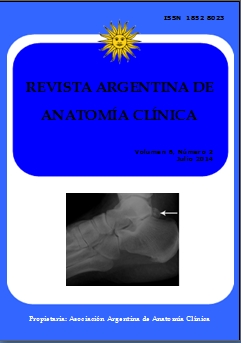HUMAN BODIES TO TEACH ANATOMY: IMPORTANCE AND PROCUREMENT: EXPERIENCE WITH CADAVER DONATION. Cuerpos humanos para la enseñanza de la Anatomía: Importancia y procuración: Experiencia con la donación de cadáveres
DOI:
https://doi.org/10.31051/1852.8023.v6.n2.14127Keywords:
Anatomy teaching, cadaveric material, cadaveric dissection, donation of cadavers, Enseñanza de Anatomia, material cadavérico, disección cadavérica, donación de cadáveresAbstract
Este Debate fue propuesto para aportar diferentes puntos de vista y conocer la diversidad de circunstancias involucradas en la procuración y uso de cadáveres para la enseñanza de la Anatomía, a estudiantes de pre y post-grado, en el mundo. Un grupo reducido pero representativo de profesores de Anatomía de todos los continentes fueron invitados a participar. Se distribuyeron algunos lineamientos para que los escritos tuvieran similar orientación, aunque los autores podían incluir cualquier concepto que consideraran de interés para los lectores. Además de los profesores de diversos países, el Prof. Bernard Moxham (Presidente de IFAA) aportó al Debate la posición oficial de la Federación Internacional de Asociaciones de Anatomistas. Los panelistas acordaron en la importancia de utilizar material cadavérico para la enseñanza de la Anatomía, sin embargo, la provisión, las fuentes y los procedimientos utilizados para adquirirlos fueron algo diferentes de un país y/o universidad a otro. La experiencia de los países europeos, las limitaciones culturales en los asiáticos y africanos, y el retraso y los problemas estructurales en Sudamérica, son algunas de las particularidades que se señalan. Después de esta publicación se recibirán las preguntas y comentarios no solo de los participantes sino también de los lectores en general, las cuales serán respondidas y ambas, preguntas y respuestas, publicadas en el próximo número. Entonces, el Debate alcanzará su punto máximo al permitir a todas las personas involucradas en el tema, en cualquier lugar del mundo, participar y aportar información adicional.
This Debate was proposed to provide different points of view and to know the diversity of circumstances involved in the procurement and use of cadavers to teach Anatomy, to pre and post-graduate students, all over the world. A reduced but representative group of professors of Anatomy of all continents were invited to participate. Some guidelines were distributed to give a common orientation to each paper instead authors were able to include whatever they considered to be of reader’s interest. Within the professors from different countries, Prof. Bernard Moxham (IFAA President) supported the Debate with the International Federation of Associations of Anatomists official position. The panelists agreed about the importance of using cadaveric material to teach Anatomy, but the provision, sources and procedures followed to get them are quite different from one to another country and/or university. The experience of European countries, the cultural limitations in Asiatic and African ones, the delay and structural problems in South America, are some of the pointed peculiarities. After this publication we will receive the questions and comments, not only from the Debate participants but also from general readers, which will be answered and both, questions and answers, published in the next issue. Then, the Debate may reach its top point by letting involved people from all over the world to take part and provide additional information.
Downloads
Published
Issue
Section
License
Authors retain copyright and grant the journal right of first publication with the work simultaneously licensed under a Creative Commons Attribution License that allows others to share the work with an acknowledgement of the work's authorship and initial publication in this journal. Use restricted to non commercial purposes.
Once the manuscript has been accepted for publications, authors will sign a Copyright Transfer Agreement to let the “Asociación Argentina de Anatomía Clínica” (Argentine Association of Clinical Anatomy) to edit, publish and disseminate the contribution.



